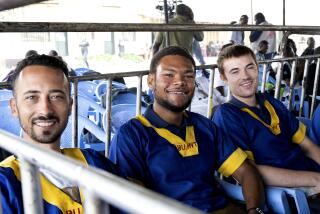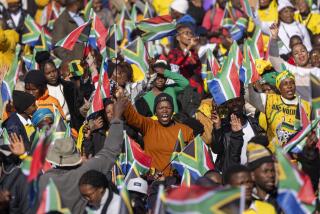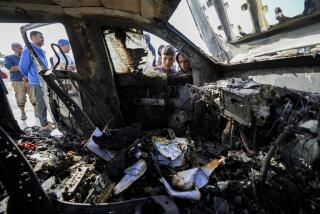South Africa Puts Ex-Military Brass on Trial in 1987 Massacre
DURBAN, South Africa — History will record that a defining moment in the post-apartheid period occurred in a steamy courtroom here Monday.
There sat former Defense Minister Magnus Malan, once one of South Africa’s most feared figures, armed with a thin plaid pillow for the hard wooden bench. Beside the retired general, crammed into two long pews, sat nearly the entire top military command of the former white-minority regime.
And then the 20 defendants--including five retired generals--stood one by one and solemnly pleaded not guilty to murder, attempted murder and conspiracy charges stemming from a 1987 massacre of 13 unarmed civilians, most of them women and children.
When it was Malan’s turn, he rose slowly, carefully buttoned the jacket of his pinstriped charcoal suit and clasped his hands behind him before speaking Afrikaans in a low, gravelly voice. Then he sat, staring ahead intently.
The arresting start of the trial of the generals marks the first time that senior “securocrats,” as they were called, of the former government have been charged with using the vast security apparatus of the apartheid police state to commit mass murder and mayhem in a deliberate attempt to prop up white rule.
“This prosecution will cast a shaft of judicial light into a corner of our history which has hitherto been dark and secret,” Tim McNally, the provincial attorney general, said in his opening statement. “That process has now begun. It is a process of truth and justice.”
But at least one of the spectators in the heavily guarded Durban Supreme Court called for revenge against the former pillars of white rule.
“They were the government of the time,” Sidney Ntuli, 70, who lost three relatives in the attack, said bitterly. “They must go to jail. The death penalty is too quick. They wouldn’t feel it. They must suffer.”
In a sense, they already have. No South African court has ever seen such powerful figures charged as criminals. Where once were warriors were now aging men in drab business suits, forced to pass jeering crowds outside. In the late afternoon, police used a water cannon to disperse about 150 protesters on the stone steps of the courthouse.
If convicted, Malan and his co-defendants could face life in prison; the death penalty has been outlawed in South Africa. The case is being tried by Justice Jan Hugo and two assistants. Juries are not used here.
The case is being closely watched, with black and white political leaders largely split over the wisdom of exposing such sordid wounds while the country’s young democracy struggles for stability. Malan, who served as defense minister from 1980 until 1991, has warned that the trial could cause political and financial turmoil, although none has materialized.
Government officials hope that the high-profile trial will persuade other suspected miscreants to testify before the country’s Truth and Reconciliation Commission, which will hold its first hearing April 16. The panel can grant amnesty to anyone who confesses to a politically motivated crime during apartheid, but it has no power to prosecute or punish those who don’t comply.
The chilling 65-page indictment accuses Malan and his co-defendants of secretly training, paying and arming Zulu death squads for use against the then-banned African National Congress and its political allies in the 1980s.
The creation of a “third force” of government-backed hit squads has been long suspected and is widely blamed for exacerbating the political bloodletting that caused more than 20,000 deaths in the decade leading up to South Africa’s first all-race elections in April 1994.
Court papers allege that the covert plan, called Operation Marion, was hatched in 1985 after Zulu Chief Mangosuthu Buthelezi, who heads the Inkatha Freedom Party--then as now the bitter rival of the ANC--asked the military for help in his turf battle with the United Democratic Front, an antiapartheid group that was closely aligned with the ANC.
Buthelezi, who serves as home affairs minister in President Nelson Mandela’s coalition Cabinet, has not been charged in the case, although he is repeatedly cited in the indictment. McNally told the court Monday that he may call him as a witness.
But Zakhele Khumalo, Buthelezi’s chief aide at the time of the massacre, has been charged. So have the officers Buthelezi allegedly met: Gen. Tienie Groenewald, the former military intelligence chief, and Vice Adm. Dries Putter, the former chief of staff for intelligence. Gen. Kat Liebenberg and Gen. Jannie Geldenhuys, both former heads of the defense forces, are also on trial.
According to the indictment, a subcommittee of the State Security Council headed by Malan arranged to send 200 Inkatha recruits to a secret training base, code-named Camp Hippo, to form “an offensive paramilitary unit” to protect Buthelezi’s power base and undermine the ANC.
Soon after the recruits graduated, the indictment says, Khumalo asked his military handlers to organize an attack because the trainees were “getting restless.” The instructors asked for suggested targets, but with a caveat: “Only persons whose death would have a positive impact on Inkatha must be chosen,” they wrote.
The first target was Victor Ntuli, an ANC supporter in tiny KwaMakutha township in KwaZulu-Natal province. And early on Jan. 21, 1987, prosecutors say, five trainees burst into Ntuli’s three-room shack and fired wildly with AK-47 assault rifles at everyone sleeping inside.
They left 153 spent cartridges behind, as well as the bullet-riddled corpses of 13 people. Although Ntuli was not at home, the killers called the attack a success and later celebrated, feasting on a goat provided by the military. The five alleged gunmen are among the accused.
McNally conceded Monday that Malan and the other generals did not take part in the atrocity. But he said “the owner of a vicious bulldog who unleashes it upon a crowd of people cannot be heard to lament the fact that it chooses to savage a young child.”
Prosecutors say security forces arranged a careful cover-up of their involvement, ordering police patrols out of the area and assigning a “sweeper” to remove any incriminating evidence before police arrived.
Defense lawyers, however, argued Monday that the police were simply incompetent. The first officer on the scene, Det. Allan Alford, testified that he kept no records of the carnage, didn’t stop anyone from entering the house and didn’t mark any of the evidence he collected.
Another witness, Thembinkosi Mkhize, an Inkatha official who lived next door to the victims, grimly recalled a time when terror was routine. He hid under his bed during the slaughter, he said. “I thought they’d come to attack me,” he said.
More to Read
Sign up for Essential California
The most important California stories and recommendations in your inbox every morning.
You may occasionally receive promotional content from the Los Angeles Times.











